New Process For Preserving Lumber Could Offer Advantages Over Pressure Treating
Feb 14, 2020 — Atlanta, GA

Treated and untreated pieces of lumber submerged in water. The lumber on the left has been treated using atomic layer deposition. It resists absorbing water even when submerged. On the right is untreated lumber shown for comparison. It readily soaks up water, causing a color change within seconds. (Credit: Allison Carter, Georgia Tech)
Pressure treating – which involves putting lumber inside a pressurized watertight tank and forcing chemicals into the boards – has been used for more than a century to help stave off the fungus that causes wood rot in wet environments.
Now researchers at the Georgia Institute of Technology have developed a new method that could one day replace conventional pressure treating as a way to make lumber not only fungal-resistant but also nearly impervious to water – and more thermally insulating.
The new method, which was reported February 13 in the journal Langmuir and jointly sponsored by the Department of Defense, the Gulf Research Program, and the Westendorf Undergraduate Research Fund, involves applying a protective coating of metal oxide that is only a few atoms thick throughout the entire cellular structure of the wood.
This process, known as atomic layer deposition, is already frequently used in manufacturing microelectronics for computers and cell phones but now is being explored for new applications in commodity products such as wood. Like pressure treatments, the process is performed in an airtight chamber, but in this case the chamber is at low pressures to help the gas molecules permeate the entire wood structure.
“It was really important that this coating be applied throughout the interior of the wood and not just on the surface,” said Mark Losego, an assistant professor in the School of Materials Science and Engineering. “Wood has pores that are about the width of a human hair or a little smaller, and we used these holes as our pathways for the gases to travel throughout the wood’s structure.”
As the gas molecules travel down those pathways, they react with the pore’s surfaces to deposit a conformal, atomic-scale coating of metal oxide throughout the interior of the wood. The result is wood that sheds water off its surface and resists absorbing water even when submerged.
In their experiments, the researchers took finished pine 2x4s and cut them into one-inch pieces. They then tested infusing the lumber with three different kinds of metal oxides: titanium oxide, aluminum oxide and zinc oxide. With each, they compared the water absorption after holding the lumber under water for a period of time. Of the three, titanium oxide performed the best by helping the wood absorb the least amount of water. By comparison, untreated lumber absorbed three times as much water.
“Of the three chemistries that we tried, titanium oxide proved the most effective at creating the hydrophobic barrier,” said Shawn Gregory, a graduate student at Georgia Tech and lead author on the paper. “We hypothesize that this is likely because of how the precursor chemicals for titanium dioxide react less readily with the pore surfaces and therefore have an easier time penetrating deep within the pores of the wood.”
Losego said that the same phenomena exist in atomic layer deposition processes used for microelectronic devices.
“These same titanium oxide precursor chemistries are known to better penetrate and conformally coat complex nanostructures in microelectronics just like we see in the wood,” Losego said. “These commonalities in understanding fundamental physical phenomena – even in what appear to be very different systems – is what makes science so elegant and powerful.”
In addition to being hydrophobic, lumber treated with the new vapor process also resists the mold that eventually leads to rot.
“Interestingly, when we left these blocks sit in a humid environment for several months, we noticed that the titanium oxide treated blocks were much more resistant to mold growth than the untreated lumber,” Gregory added. “We suspect that this has something to do with its hydrophobic nature, although there could be other chemical effects associated with the new treatment process that could also be responsible. That’s something we would want to investigate in future research.”
Yet another benefit of the new process: vapor-treated wood was far less thermally conductive compared to untreated wood.
“A lot of attention is paid in home building to insulating the cavities between the structural components of a home, but a massive amount of the thermal losses are caused by the wood studs themselves,” said Shannon Yee, an associate professor in the George W. Woodruff School of Mechanical Engineering and a co-author on the paper with expertise in thermal systems. “Lumber treated with this new process can be up to 30 percent less conductive, which could translate to a savings of as much as 2 million BTUs of energy per dwelling per year."
This material is based upon work supported by the Office of Naval Research through grant No. N00014-19-1-2162, the Department of Defense through the National Defense Science & Engineering Graduate Fellowship Program, the Gulf Research Program managed by the National Academies, and a donation from Roxanne Westendorf. Any opinions, findings, and conclusions or recommendations expressed in this material are those of the authors and do not necessarily reflect the views of the sponsoring agencies.
CITATION: Shawn A. Gregory, Connor P. McGettigan, Emily K. McGuinness, David Misha Rodin, Shannon K. Yee, and Mark D. Losego, “Single-Cycle Atomic Layer Deposition (1cy-ALD) on Bulk Wood Lumber for Managing Moisture Content, Mold Growth, and Thermal Conductivity,” (Langmuir, February 2020). http://dx.doi.org/10.1021/acs.langmuir.9b03273
Research News
Georgia Institute of Technology
177 North Avenue
Atlanta, Georgia 30332-0181 USA
Media Relations Contact: John Toon (404-894-6986) (jtoon@gatech.edu).
Writer: Josh Brown
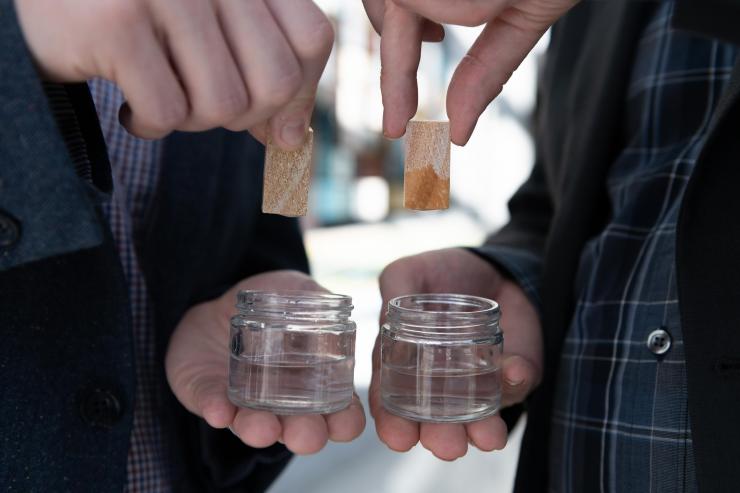
Two pieces of lumber shown after being submerged in water. On the left side is lumber that has been treated using atomic layer deposition and resisted absorbing water. On the right side is untreated lumber that readily absorbs water shown for comparison. (Credit: Allison Carter, Georgia Tech)
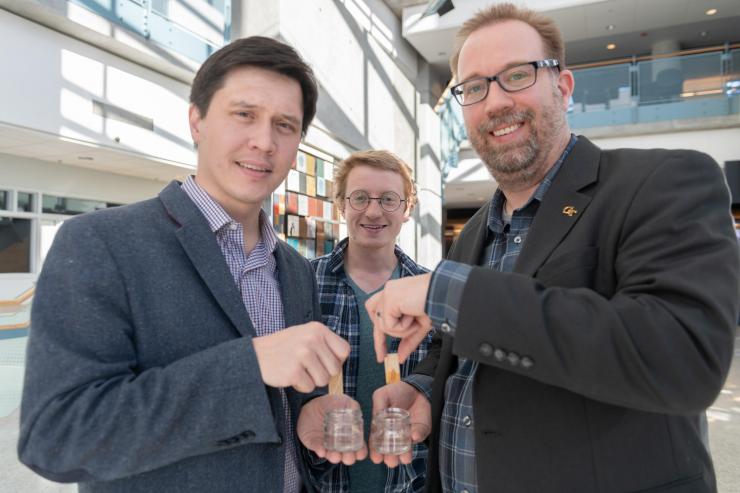
From left to right, Shannon Yee, an associate professor in the Woodruff School of Mechanical Engineering, Shawn Gregory, a graduate student at Georgia Tech, and Mark Losego, an assistant professor in the School of Materials Science and Engineering, demonstrate the water repellent qualities of a new lumber treatment process based upon atomic layer deposition. (Credit: Allison Carter, Georgia Tech)
John Toon
Research News
(404) 894-6986
Executive Director Selected at Renewable Bioproducts Institute
Feb 12, 2020 — Atlanta, GA

Carson Meredith, professor and James Harris Faculty Fellow in Georgia Tech’s School of Chemical and Biomolecular Engineering, is the new executive director of the Renewable Bioproducts Institute.(Photo: Christopher Moore, Georgia Tech).
The Georgia Institute of Technology has selected Carson Meredith as the new executive director of the Renewable Bioproducts Institute (RBI). Meredith is a professor and James Harris Faculty Fellow in Georgia Tech’s School of Chemical and Biomolecular Engineering (ChBE).
Meredith, who earned his undergraduate degree at Georgia Tech (B.S., chemical engineering), has been on the ChBE faculty since 2000. He also served as the school’s associate chair for graduate studies between 2012-2019.
“Carson and his research team have pioneered the use of sustainable technologies for a variety of important applications,” said Raheem Beyah, Georgia Tech’s Vice President for Interdisciplinary Research. “We are pleased that he will be leading our Renewable Bioproducts Institute as it develops new products, processes and technologies for industries that include paper and packaging, biochemicals and fuels, and bio-composites and nanocellulose.”
Meredith’s lab researches the surfaces and interfaces of advanced materials, emphasizing renewable components, sustainable processing, and bioinspired designs in adhesives, composites, foams, and coatings, among other things. Borrowing their ideas from nature, Meredith and his team are addressing the needs of human societies through food security, renewables, and energy efficiency, utilizing natural materials.
“We’ve focused on using cellulose nanomaterials to make alternatives to conventional plastic for all kinds of things, including high performance food packaging that prevents spoilage, and we’re looking at ways in which we can replace some plastics used in paints and coatings,” said Meredith, who has been an RBI investigator for 10 years.
“Society is demanding alternatives to plastics that accumulate in the environment, and I’m excited that RBI is positioned to offer solutions,” he added. “There’s a tremendous amount of energy coming from industry to develop new bioproducts.”
After earning his undergraduate degree from Georgia Tech, Meredith earned a Ph.D. in chemical engineering from the University of Texas at Austin and served as a postdoctoral researcher at the National Institutes of Standards and Technology (NIST) before returning to Georgia Tech as a faculty member.
RBI, comprised of 50 faculty researchers from six colleges and research centers across Georgia Tech, began as the Institute of Paper Chemistry in 1929 in Wisconsin. Moving to Georgia Tech 60 years later as the Institute for Paper Science and Technology, it was renamed the Renewable Bioproducts Institute in 2014, buoyed by a $43.6 million gift from the Institute of Paper Chemistry Foundation (IPCF), which supports the institute’s expanded aim of research to unlock the potential of biomass material for a wide range of products.
Research News
Georgia Institute of Technology
177 North Avenue
Atlanta, Georgia 30332-0181 USA
Media Relations Assistance: John Toon (404-894-6096) (jtoon@gatech.edu)
Writer: Jerry Grillo
John Toon
Research News
(404) 894-6986
RBI affiliated researchers attend nanocellulose workshop on advancing commercialization
May 20, 2019 — Atlanta, GA
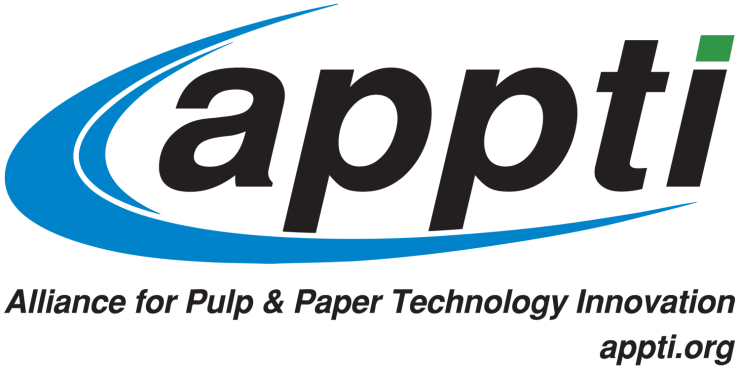
Agenda 2020 is now APPTI
RBI affiliated researchers attend nanocellulose workshop on advancing commercialization
WASHINGTON, DC — The Alliance for Pulp and Paper Technology and Innovation (APPTI), in collaboration with the USDA Forest Service and the National Nanotechnology Coordinating Office (NNCO), held a workshop Advancing Commercialization of Nanocellulose – Critical Challenges,May 7-8 in Washington, DC. Sixty-six people from 44 companies, five government entities and 14 universities participated in the event.
Georgia Tech’s Renewable Bioproducts Institute (RBI) was represented by several researchers and faculty, including RBI’s Interim Executive Director and Associate Professor Meisha Shofner(MSE), Professor Carson Meredith(ChBE), Professor Yulin Deng(ChBE) and Senior Research Engineer Scott Sinquefield.
The two-day session was devoted to determining critical knowledge gaps and research needs which, if overcome, would have the greatest impact on accelerating widespread implementation and commercialization of nanocellulose materials and applications.
"The workshop was an important venue for continuing the conversation about realizing the potential of nanocellulose,” Shofner said. “It brought together diverse stakeholders in the nanocellulose area to address some key challenges in the field and provided opportunities to learn more about the capabilities of these stakeholders, including RBI."
Presentations of two literature reviews focused on those very challenges were delivered on compatibilization and on drying & dewatering by lead authors Greg Schueneman (U.S. Forest Service) and Sinquefield, respectively. These reviews were commissioned well in advance of the workshop and addressed two well-known grand challenges in commercializing of nanocellulose. They are now being prepared for publication.
The context centered on nanocellulose being produced in aqueous suspensions of only a few percent solids and becoming very viscous with increasing solids content. Even a 10% nanocellulose suspension takes the form of a thick paste, not conducive to pumping or spraying. Effective drying and dewatering processes will greatly reduce transportation costs. However there is a high degree of surface reactivity that must be preserved. The second paper by Sinquefield, “A Review of Nanocellulose Drying and Dewatering,” concluded that no conventional commercial drying unit operation alone has been found to be adequate. Nanocellulose fibrils and crystals have a high concentration of surface hydroxyl groups, which form intra-fiber bonds during drying resulting in agglomerates that resist redispersion following drying.
“Various additives have been found that sorb to active surface sites and prevent the fibers from re-combining. These additives tend to be costly and require complex processing, including recovery for reuse,” Sinquefield said. “The cost is justified for high value products, but more research is needed to develop low-cost methods of drying and dewatering nanocellulose such that it can completely redisperse in either water or non-polar mediums.”
The knowledge gaps and research needs were further prioritized at the workshop.
Alexander Friend, deputy chief of the U.S. Forest Service, cited the encouraging increase in nanocellulose production volume to 20,000 tons per year. He noted that the Forest Service’s investment contributions in developing US production capability represented a commitment to nanocellulose “to sustain the health, diversity, and productivity of the nation’s forests and grasslands to meet the needs of present and future generations.”
Small groups identified and prioritized research needs to address remaining knowledge gaps in the areas of compatibilization of nanocellulose with other materials such as plastics, and of drying and dewatering. They then developed potential research approaches that might provide solutions to those needs. Going forward, APPTI and its nanocellulose team, along with its partners, will seek to execute the identified priority projects. Two opportunities for DoE funding were announced recently for which these projects could potentially apply (seeDoE Innovative Manufacturing and DoE BETO Opportunity).
For further information, visit www.appti.org.
Kelly Beasley Smith, kelly.smith@gatech.edu
Domtar Leaders Recognized for Management Excellence
May 13, 2019 — Atlanta, GA
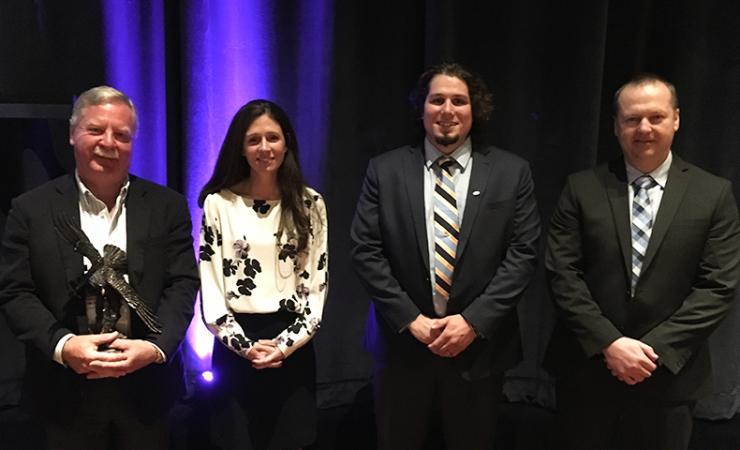
Domtar’s PaperCon award winners: (from left) John D. Williams, Kerry Brown, Michael J. Subilia II, and Greg Linscott.
Domtar Leaders Recognized for Management Excellence
The Paper Industry Management Association (PIMA) bestowed its highest honor on Domtar President and CEO John D. Williams at the Technical Association of the Pulp and Paper Industry’s annual PaperCon in May. Williams was named Executive of the Year in recognition of his leadership, his contributions to the pulp and paper industry, and his management excellence.
PIMA cited Williams’ outstanding leadership over the course of 10 years as Domtar CEO, including his ability to continually evaluate long-term strategy while achieving strong short-term results. Thanks to his management excellence, we have experienced continued growth as North America’s leading uncoated free-sheet producer. We’ve also developed a robust biomaterials business to leverage our expertise in refining biomass as the world transitions from fossil fuels to a bio-based economy.
“I am very grateful to receive this prestigious honor,” Williams said at the event. “However, I cannot take full credit for our success. Our most valued asset at Domtar is our wonderful employees. They are the front line of our business and our true competitive advantage.”
While at the conference, Williams also spoke on an executive panel about sustainability and the ongoing trend toward a bio-based economy.
“Markets or end users that want to move away from plastics or petroleum-based products toward more sustainable and renewable products need a solution that performs on par with their current products and also has a robust build-out supply chain and scale,” he said. “We are providing bio-based solutions to incumbents in the plastics, materials and chemicals industries to help them and their customers achieve their own mandates to become more sustainable and move away from traditional petroleum-based plastics and materials.”
To read the entire article click here
kelly.smith@gatech.edu
Two new exhibits open at Robert C. Williams Museum of Papermaking
Apr 16, 2019 — Atlanta, GA
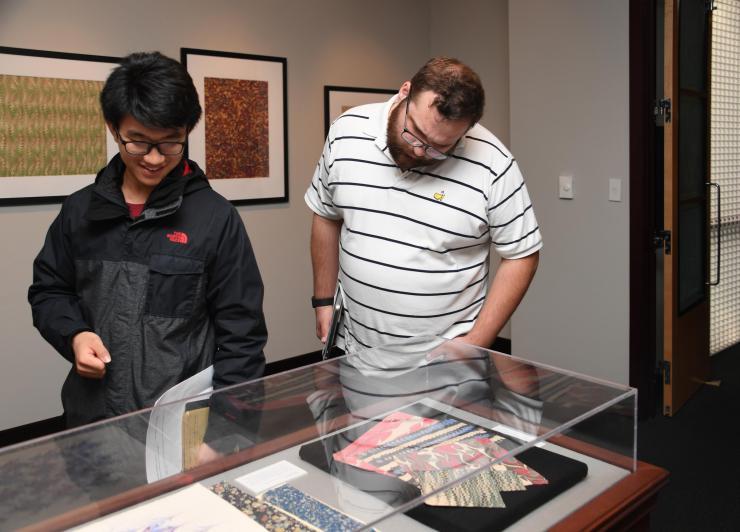
Papermaking Museum: RBI Fellows Xirui Peng, ME, and Daniel Kimmel, ME, view papers on display during the opening of 'Marvelous Marbling: Demystifying Marbled Papers'
The Robert C. Williams Museum of Papermaking recently celebrated the opening of two new exhibits: Marvelous Marblingand Postage Required.
The museum is housed within the Renewable Bioproducts Institute on Georgia Tech’s campus.
Marvelous Marblingfeatures a selection of marbled papers from the museum’s extensive collection. Most of the works on exhibit are from the early 20th century and were made by friends and colleagues of the museum’s founder Dard Hunter. The exhibit focuses on how marbled papers are produced. Each sample is one-of-a-kind, and different methods produced different results.
“These marbled papers are really beautiful, and many were made to become end papers in books, or to line boxes,” said Museum Director Virginia Howell. “It’s hard to believe these are handmade, and seeing the steps to create them reveals that there was as much science as art involved in the process.”
Postage Requiredwas a collaboration with Dr. Patrick Ellis, a Brittain Fellow in Georgia Tech’s Literature, Media and Communications Department. The exhibit includes dozens of postcards from the early 20thcentury. Rather than just simple cards, these include tabs, wheels and other features that give these postcards movable parts and animation.
“These were the social media of a century ago … they were quick, inexpensive and available everywhere,” said Museum Coordinator Jerushia Graham. “Postage Required shows the cutting edge technology of the past. We still send postcards to document trips or a quick note, though text messages have replaced much of that communication.”
The Robert C. Williams Museum of Papermaking is open Monday – Friday from 9 a.m. to 5 p.m. Admission is free. Groups of 10 or more must book a fee-based program in advance. For more information, including contacts and directions, please visit our website.
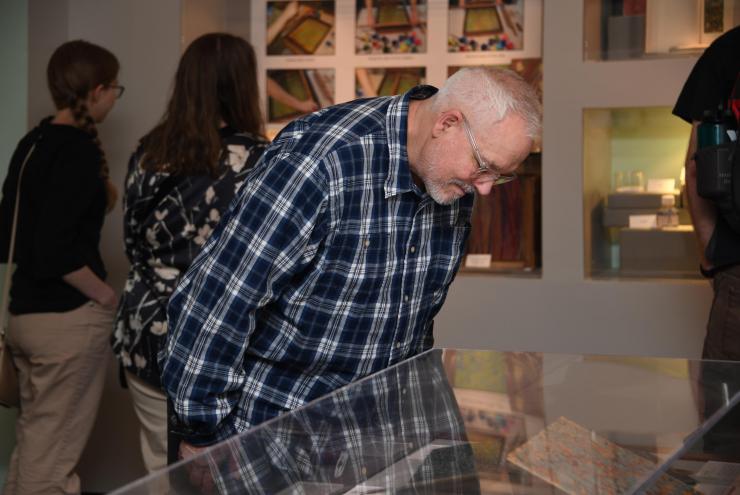
Papermaking Museum: Robert Thompson views items on display at the exhibit 'Marvelous Marbling: Demystifying Marbled Papers'
Virginia Howell, Museum Director, virginia.howell@rbi.gatech.edu
RBI announces 2019-20 Fellowship awards
Apr 16, 2019 — Atlanta, GA
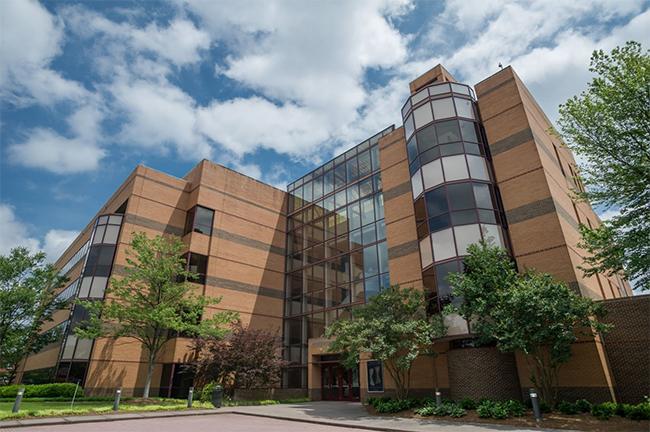
The Renewable Bioproducts Institute has announced four new Fellowship awards for the upcoming academic year.
The selected projects include:
“Control of Fiber Orientation in Dispersion of Microbubbles with Application to Multiphase Web Forming,” Professor Cyrus Aidun (ME) and Associate Chair and Professor Devesh Ranjan (ME)
“Degradation and Recycling of Paper Towels and Packaging: Triggered Degradation of Crosslinks,” Assistant Professor Blair Brettmann (ChBE/MSE) and Associate Professor Stefan France (CHEM)
“Non-thermal Fractionation of Crude Tall Oil and Crude Sulfate Turpentine,” Associate Professor Ryan Lively (ChBE) and School Chair and Professor M.G. Finn (CHEM)
“Advancing Nanocellulose-Based Barrier Packaging: Performance and Manufacturability via Hybrids with Soluble Polysaccarides and Metal Oxides,” Professor Carson Meredith (ChBE) and Professor Natalie Stingelin (MSE/ChBE)
The lead faculty of each project will recruit students to join their teams in the fall.
Each year, the executive director of RBI issues a Request for Proposals (RFP) to Georgia Tech faculty. Fellowships are awarded based on alignment with the strategic thrusts of Georgia Tech and RBI, and the research priorities of the forest bioproducts industry.
The Fellowships are funded through a major grant awarded to Georgia Tech from the Institute of Paper Chemistry Foundation (IPCF) in 2014. One of the largest gifts in Georgia Tech’s history, it affirmed the Institute’s position as the leading driver in the forest bioproducts arena. This gift constitutes the funding that supports the RBI graduate research fellowships.
The Fellowship supports approximately 40 students each year who conduct faculty-directed research to advance technologies and applications in the bioeconomy.
For more information about the RFP and the Fellowship program, visit our website.
Kelly B Smith, kelly.smith@gatech.edu
IPC Class of 1964 alum makes gift to RBI Endowment
Apr 09, 2019 — Atlanta, GA

Elvin Walker, IPC Class of 64
Georgia Tech’s Renewable Bioproducts Institute recently received a generous financial gift to be applied to its Fellowship program.
The Fellowship supports more than 40 Ph.D. students based on their alignment with the strategic thrusts of Georgia Tech and RBI and the research priorities of the forest bioproducts industry.
Dr. Elvin F. and Mrs. Walker’s gift will be applied toward the principal of RBI’s more than $40 million endowment and will support through perpetuity the graduate program.
"We are so pleased and grateful that the IPC/IPST alumni continue to support the current activities in RBI,” said Meisha Shofner, who currently serves as RBI’s interim executive director. “The applications for bioproducts are rapidly expanding, providing more opportunities for RBI's activities to benefit society, and making gifts like those from the Walkers even more impactful."
Dr. Walker received his bachelor’s degree in Chemical and Biomolecular Engineering from Georgia Tech in 1958 and his master’s from Lawrence College in 1960. He earned his Ph.D. in 1964 from the Institute of Paper Chemistry (IPC) – the forerunner of RBI – in Appleton, Wisc. He delivered his doctoral dissertation in June 1964 titled “Effects of the Uronic Acid Carboxyls on the Sorption of 4-0-Methylglucuronoarabinoxylans and Their Influence on Papermaking Properties of Cellulose Fibers.” His full dissertation can be read here.
Dr. Walker built a long and successful career within the pulp and paper industry. He has since retired and lives in the Charlotte, N.C., area.
Kelly B. Smith, kelly.smith@gatech.edu
Virginia Howell named Director of Robert C. Williams Museum of Papermaking
Apr 04, 2019 — Atlanta, GA
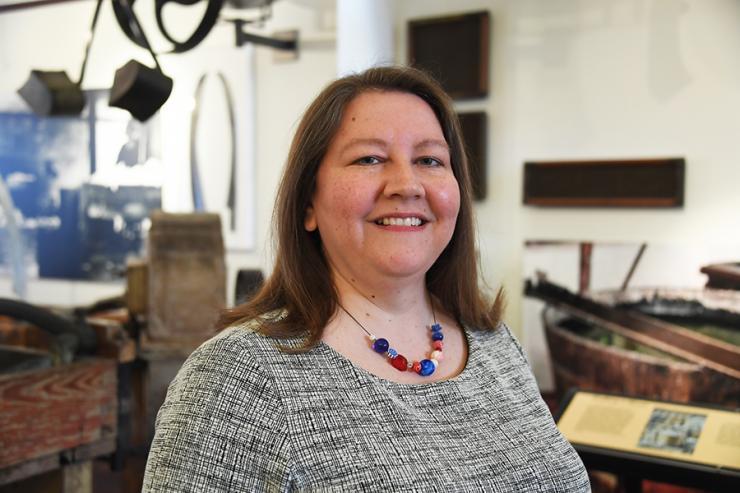
Virginia Howell is the new Director of the Robert C. Williams Museum of Papermaking
Georgia Tech’s Renewable Bioproducts Institute has announced Virginia Howell as Director of the Robert C. Williams Museum of Papermaking. Howell has served as Education Curator at the Museum since 2013.
The Robert C. Williams Museum of Papermaking, supported in part by RBI and housed in its buildling on campus, was founded by Dard Hunter in the 1930s and integrated into the Georgia Tech system in 2003. It is an internationally renowned resource on the history of paper and paper technology. In addition to more than 2,000 books, the museum features a remarkable collection of over 10,000 watermarks, papers, tools, machines, and manuscripts.
“I am honored to have been selected to lead the Museum,” Howell said. “It will be a privilege to serve in a new capacity, and to put my skills to work in new ways. The museum has a long history of being supported by people who are passionate about paper, and I will do my best to live up to those expectations. I’m incredibly excited to be starting this new chapter.”
Prior to her appointment as director, Howell was responsible for developing and leading the education programs at the Paper Museum. These programs serve all ages — from kindergarteners to adults. Experiences focus on an introduction of the history of papermaking with hands-on workshops on paper-related themes, such as bookbinding and marbling papers, as well as papermaking experiences.
“My favorite part of being an educator here is getting to share just what an incredible material paper is with people,” she said. “We take paper for granted, and it’s really important for so many parts of our daily lives that its absence would be quickly noted. The universality of paper is impressive, too. It doesn’t require complicated materials to make, but you can take a lifetime to perfect it. Sharing with someone the magic of making pulp turn into a useful, familiar material is a pretty great feeling. “
Howell’s passion for paper and books was present even as a child. You could say it ran in the family.
“I have always been a paper and book person. My grandfather worked for Mead Paper his entire career, and my great-grandfather was a typesetter. As a child with my nose in a book, paper provided the foundation to explore thousands of worlds and stories.” The George Mead Education Gallery is located within the Museum.
“I was drawn to this museum in particular in because it provided the opportunity to blend science, art and history — all topics I had a passion for and that had been part of my professional experience up to that point,” she said. “The museum’s collection is spectacular, and having the resources of a major university available to support the museum were also a draw.”
The museum’s mission is to “collect, preserve, increase and disseminate knowledge about papermaking — past, present and future.” Howell said she takes that mission to heart, and it inspires her to create her own vision as director to continue to move the museum toward that goal.
“A big part of my vision coming in as director is to make the museum more visible and known to everyone, particular our students on campus. I want to hear students say they’ve visited and not only learned something, but enjoyed the experience.”
And Howell believes the story of paper — and that of the museum — are compelling.
“We’re a small museum, yes, but with a focus on a global topic. I think our story is one people should know and experience,” she said. “Having a home at Georgia Tech gives us the opportunity to blend together the science, art, and history of papermaking in unique and exciting ways. We are fortunate to have dedicated student workers and volunteers who help us serve a diverse audience, and we hope to be able to better utilize the technology of the future to share about the technology of the past.”
Rotating exhibitions are also housed in the museum gallery and often reflect what is happening within the papermaking community. The museum has hosted works of artists who have made names for themselves by utilizing paper as their artistic medium of choice. Exhibits have been featured from institutions as diverse as Dieu Donné Paper Mill to the National Center for Children’s Illustrated Literature.
Howell has served as Museum Educator at Reynolda House, Museum of American Art in Winston-Salem, NC; Program Coordinator at the North Carolina State Capitol; and an Educator at Cape Fear Museum of History and Science in Wilmington, NC. She sits on the board of the Georgia Association of Museums and Galleries.
Born and raised outside of Nashville, Tenn., Howell earned her bachelor’s degree in History and American Studies from Miami University in Oxford, Ohio. She earned a Master’s in American History from the University of Mississippi where she also worked in the University museums.
To find out more about the Robert C. Williams Museum of Papermaking, please visit their website or contact the staff.
Kelly B. Smith, kelly.smith@gatech.edu
RBI Fellow receives 2019 Blue Sky Award
Mar 28, 2019 — Atlanta, GA

RBI Fellow and PSE Graduate Chinmay Satam has been awarded the 2019 Blue Sky Award on behalf of the International Council of Forest and Paper Associations (ICFPA).
ICFPA is a worldwide network of forest and paper industry associations promoting cooperation in areas of common interest to its members. The award recognizes work that aims to bring the growing multibillion-dollar packaging industry towards sustainability.
Satam will receive his award during the ICFPA meeting in Vancouver, Canada, May 5-8, as well as be given the opportunity to present his winning project to the group and an international roundtable of industry CEOs.
Satam's research in the ChBE program focuses on new materials or products (other than in the traditional forest products industries). His winning project was entitled "Multi-layer chitin nanofiber cellulose nanocrystal-based films for sustainable barrier applications."
About the award, Satam said: "I am honored to have received this award. There are around 2.5 billion tonnes per year (worldwide) of potentially recoverable chitin, available as a low-cost resource. The current usage of forest resources represents 62 million tonnes of pure cellulose production in the US alone. Both materials can be used for the production of sustainable barrier materials and through pulp mill integration, could bring in a massive boost to the production of cellulose-based nanomaterials (and revenue) to existing pulp mills. "
He is advised by Professor Carson Meredith, Associate Chair for Graduate Studies and J. Carl Pirkle Sr. Faculty Fellow. Satam is also an active member of TAPPI's Georgia Tech chapter. GT TAPPI connects Georgia Tech scientists and engineers to the forest products, pulp, paper, packaging and related industries by delivering growth opportunities and professional network to the students and proven talent to the industry.
Kelly B Smith, kelly.smith@gatech.edu
Adhesive Formed From Bee Spit and Flower Oil Could Form Basis of New Glues
Mar 27, 2019 — Atlanta, GA
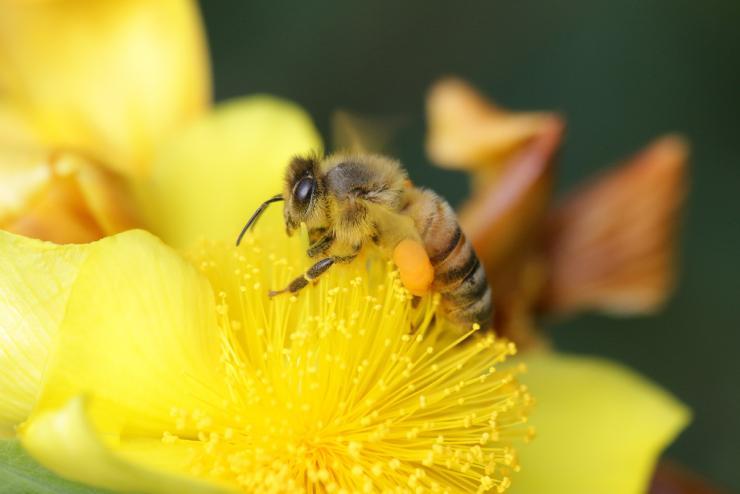
Honeybee near the Student Center. Photo by Yumiko Sakurai
Honey bees spend hours each day collecting pollen and packing it into tidy bundles attached to their hind legs.
But all of that hard work could instantly be undone during a sudden rainstorm were it not for two substances the insect uses to keep the pollen firmly stuck in place: bee spit and flower oil.
Now researchers at Georgia Institute of Technology are looking at that mixture of ingredients as a model for a bioinspired glue because of its unique adhesive properties and ability to remain sticky through a range of conditions.
“A bee encounters not just wet and humid environments but windy and dry surroundings as well, so its pollen pellet must counteract those variations in humidity while remaining adhered,” said J. Carson Meredith, a professor in Georgia Tech’s School of Chemical and Biomolecular Engineering. “Being able to withstand those kinds of changes in humidity is still a challenge for synthetic adhesives.”
In a study published March 26 in the journal Nature Communications and sponsored by the Air Force Office of Scientific Research, the researchers described how those two natural liquids work together to protect the bee’s bounty as it travels back to its hive.
The first component of the glue is the bee’s own salivary secretions, which coat the pollen grains and allow them to stick together. The bees produce those sugary secretions, the main ingredient in honey, from nectar they drink from the flowers.
The second ingredient is a plant-based oil that coats the pollen grains called pollenkitt, which helps stabilize the adhesive properties of the nectar and protect it from the impact of too much or too little humidity.
“It works similarly to a layer of cooking oil covering a pool of syrup,” Meredith said. “The oil separates the syrup from the air and slows down drying considerably.”
The researchers tested the adhesive properties of the bee’s glue by separating the oil-based component from the sugar-based component and evaluating how sticky the nectar remained under various humidity conditions. As expected, as humidity increased and the nectar absorbed more water, its adhesive properties diminished. The same effect was true when humidity decreased and the nectar dried out. Meanwhile, under similar conditions, nectar coated with the pollenkitt oil remained sticky despite changes in humidity.
“We believe you could take the essential concepts of this material and develop a novel adhesive with a water-barrier external oil layer that could better resist humidity changes in the same way,” Meredith said. “Or potentially this concept would apply to controlling the working time of an adhesive, such as its ability to flow and time to dry or cure.”
The research team, which included Victor Breedveld, an associate professor in the School of Chemical and Biomolecular Engineering, also examined dynamics of the bee adhesive.
“We wanted to know, if the pollen can stay so firmly attached to the bee’s hind legs, how do the bees manage to remove it when they return to the hive,” Meredith said.
The answer may lie in the adhesive’s a rate-sensitive response. In other words, the faster the force attempting to remove it, the more it would resist.
“This is a property of capillary adhesion, which we believe could be harnessed and tailored for specific applications, such as controlling motion in microscopic or nanoscale devices, in fields ranging from construction to medicine,” Meredith said.
This work was supported by the Air Force Office of Scientific Research under grant No. FA9550-10-1-0555. Any conclusions or recommendations are those of the authors and do not necessarily represent the official views of the sponsoring organizations.
CITATION: Donglee Shin, Won Tae Choi, Haisheng Lin, Zihao Qu, Victor Breedveld, and J. Carson Meredith, “Humidity-tolerant rate-dependent capillary viscous adhesion of bee-collected pollen fluids,” (Nature Communications, March 2019). https://doi.org/10.1038/s41467-019-09372-x
Research News
